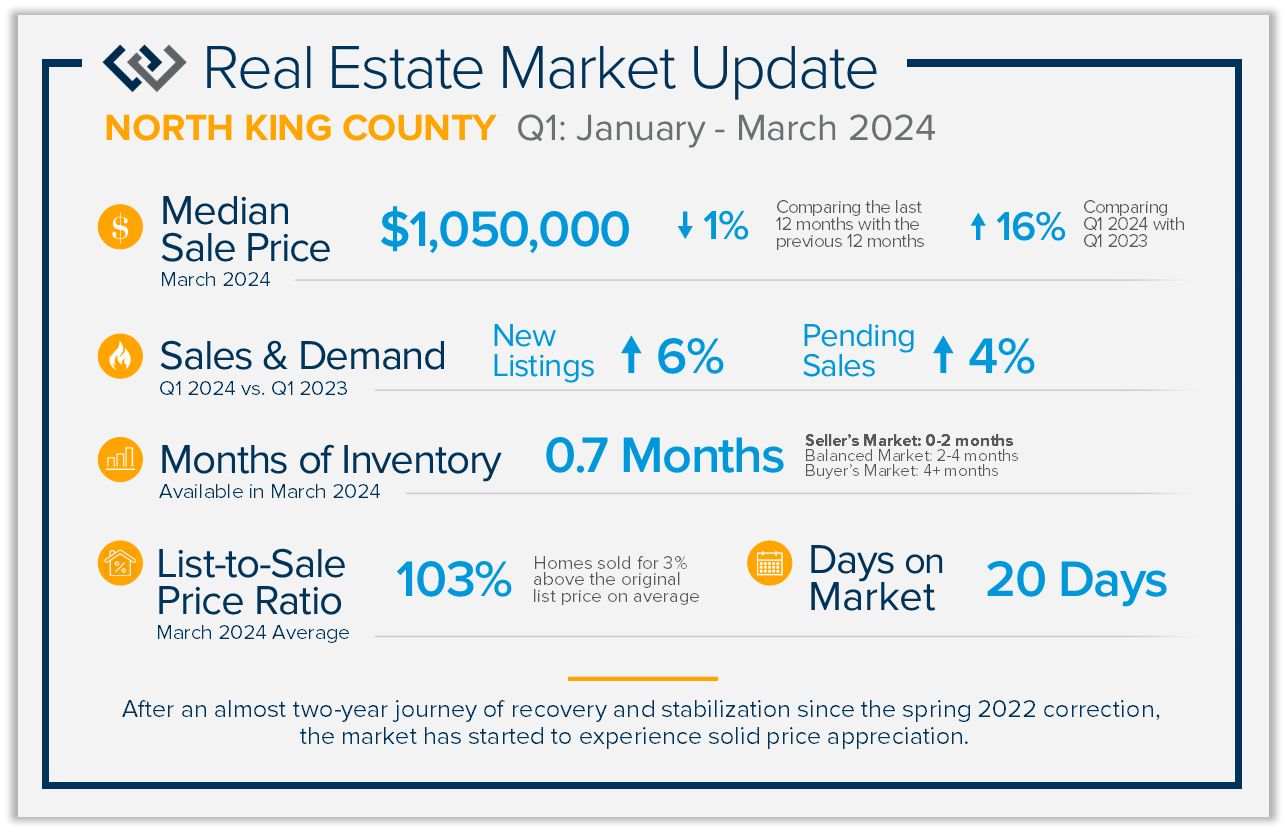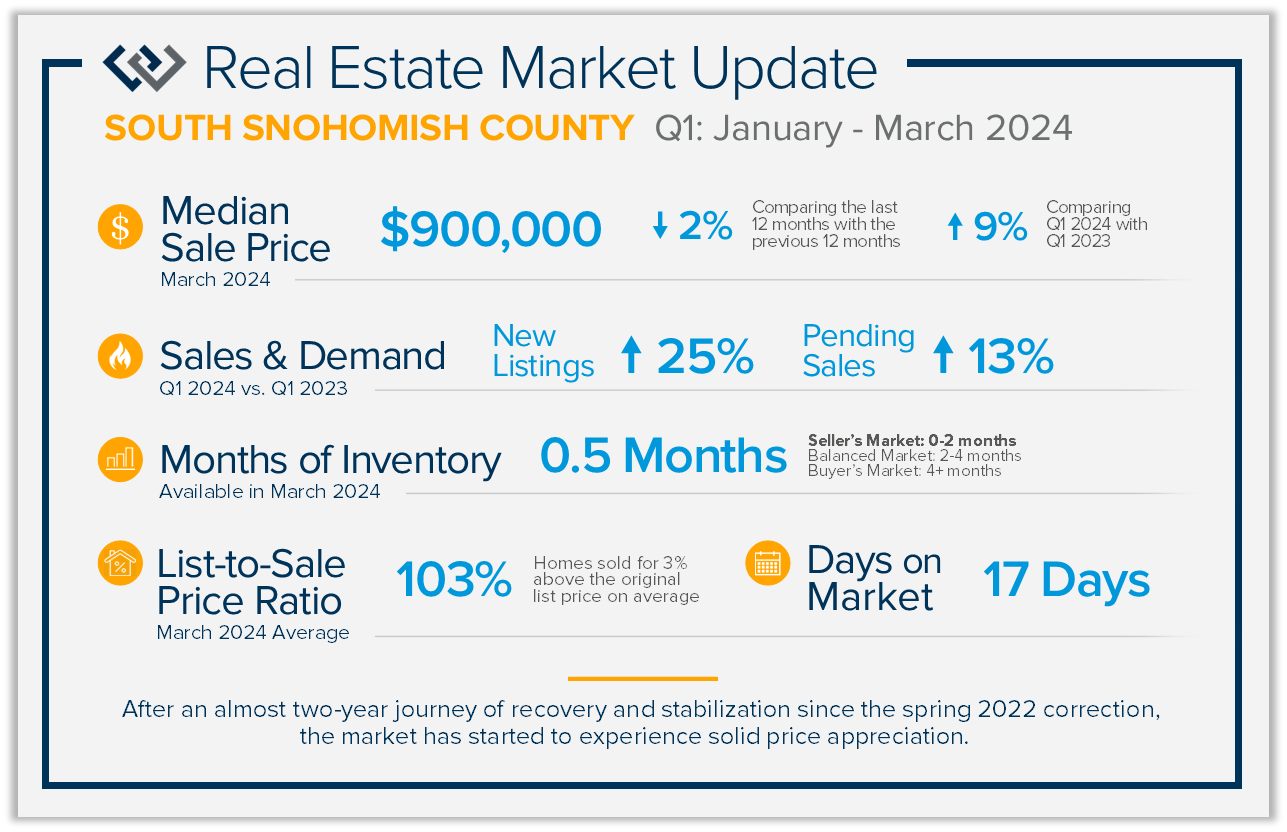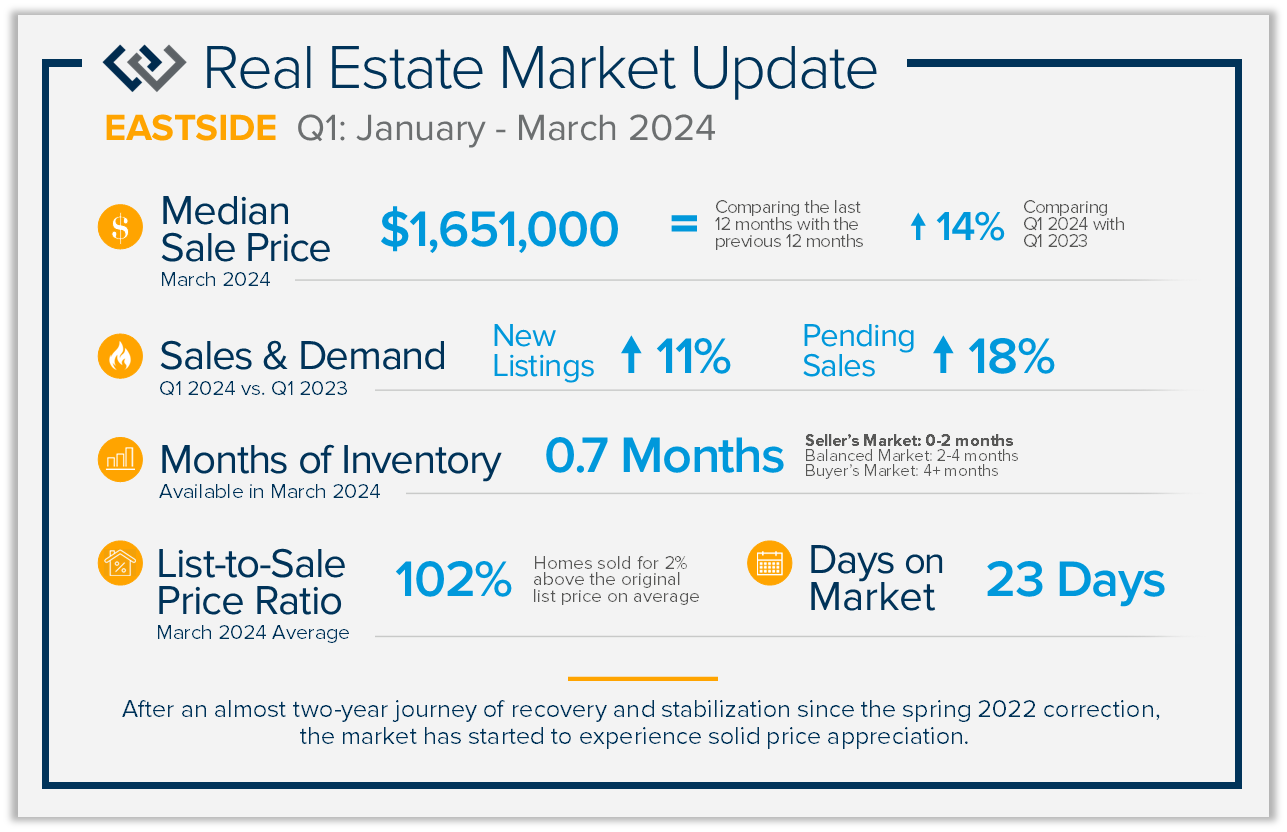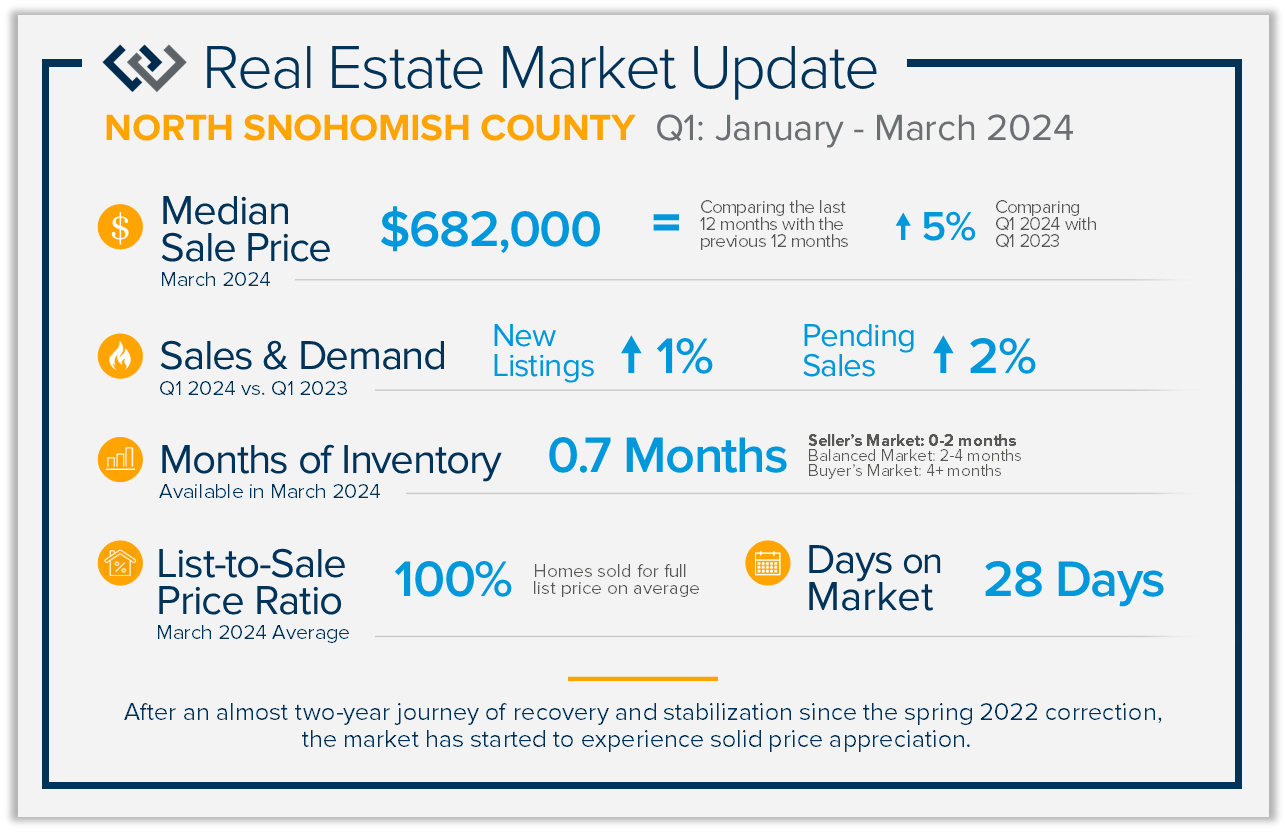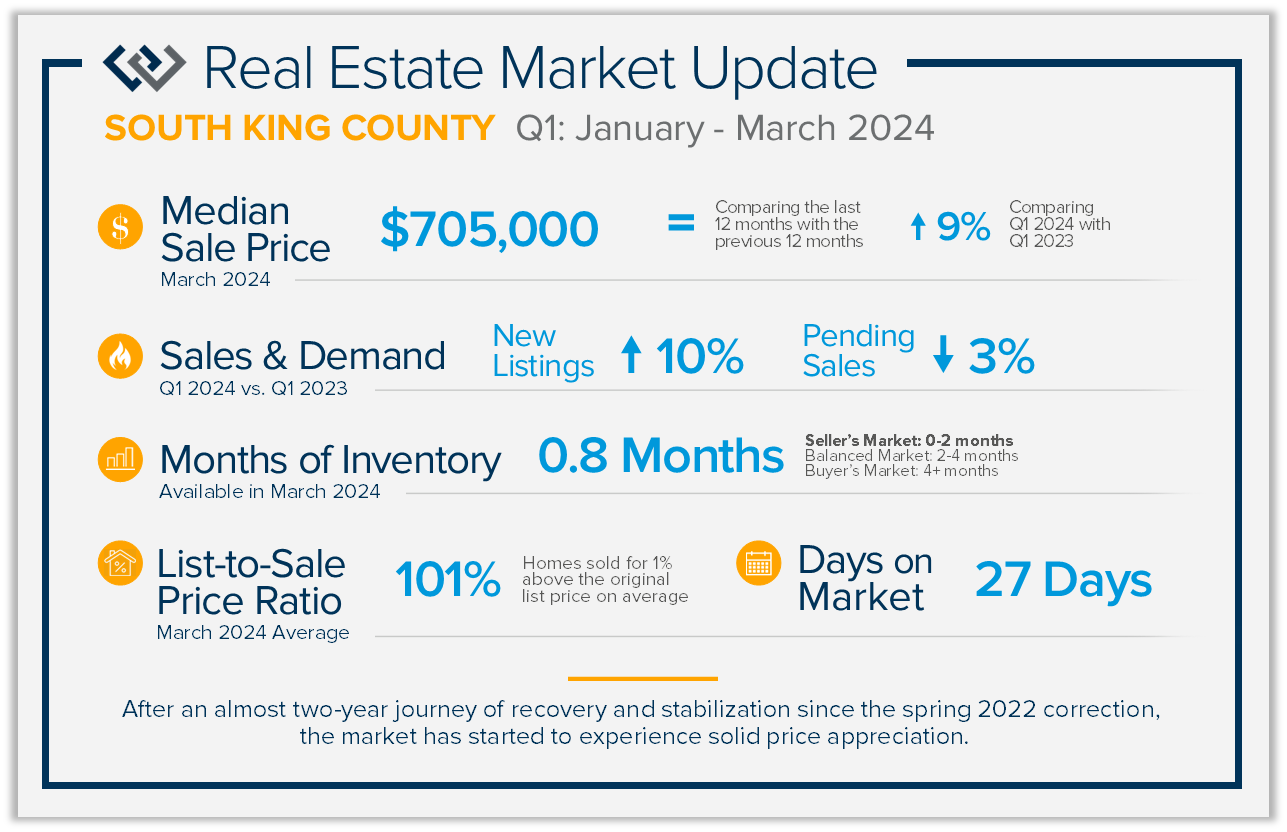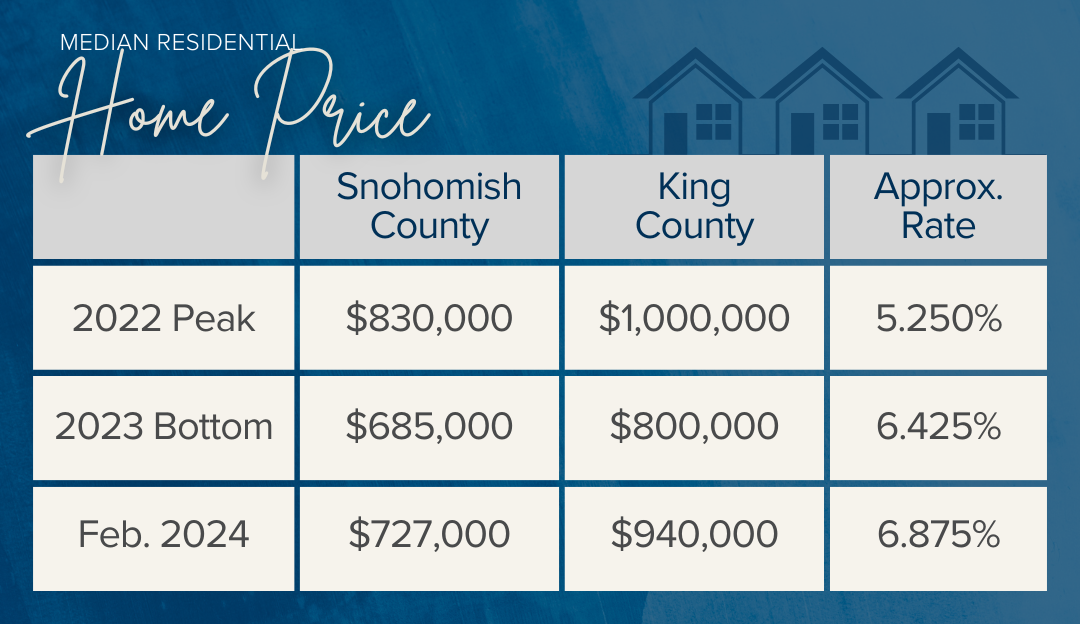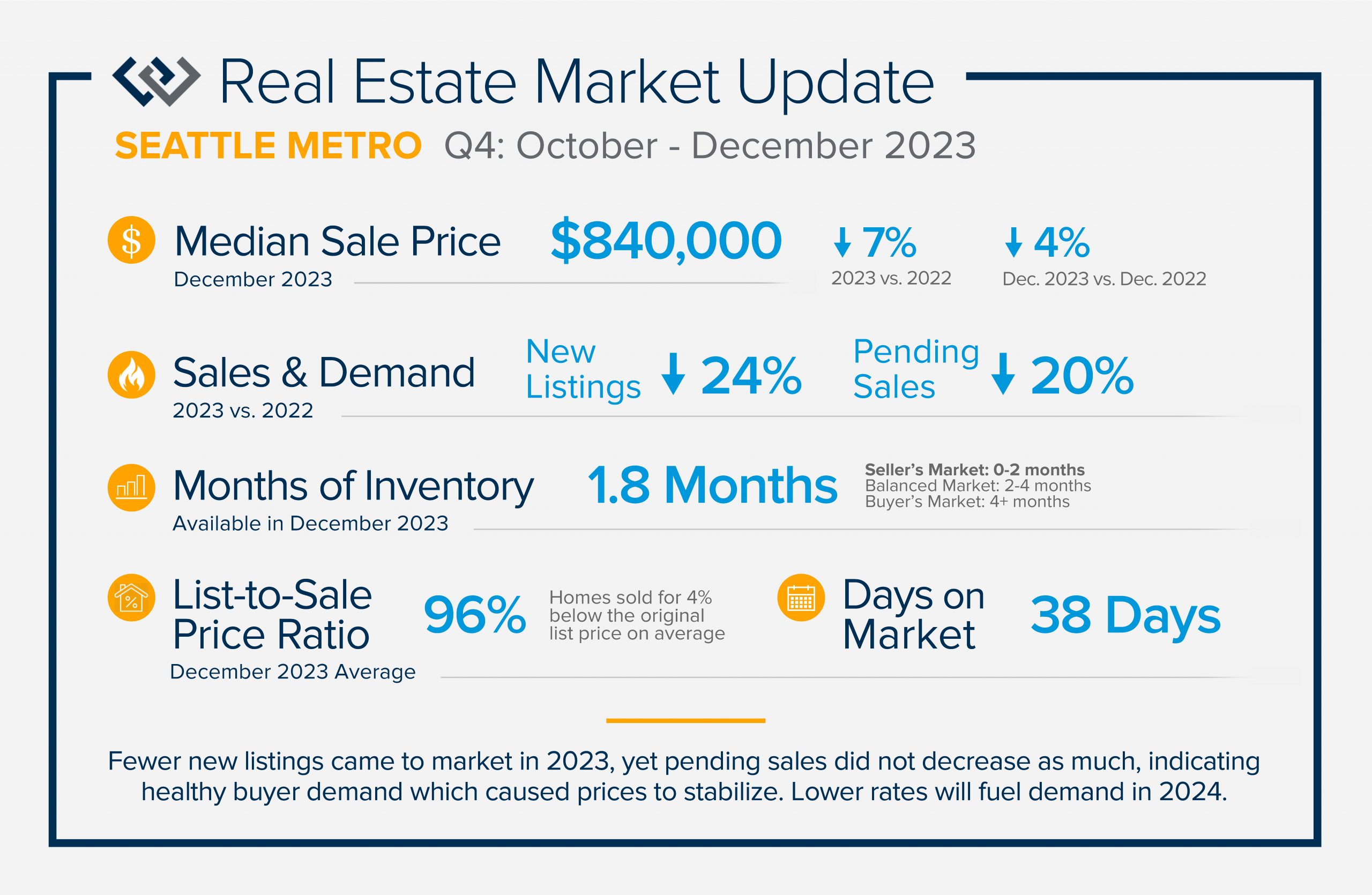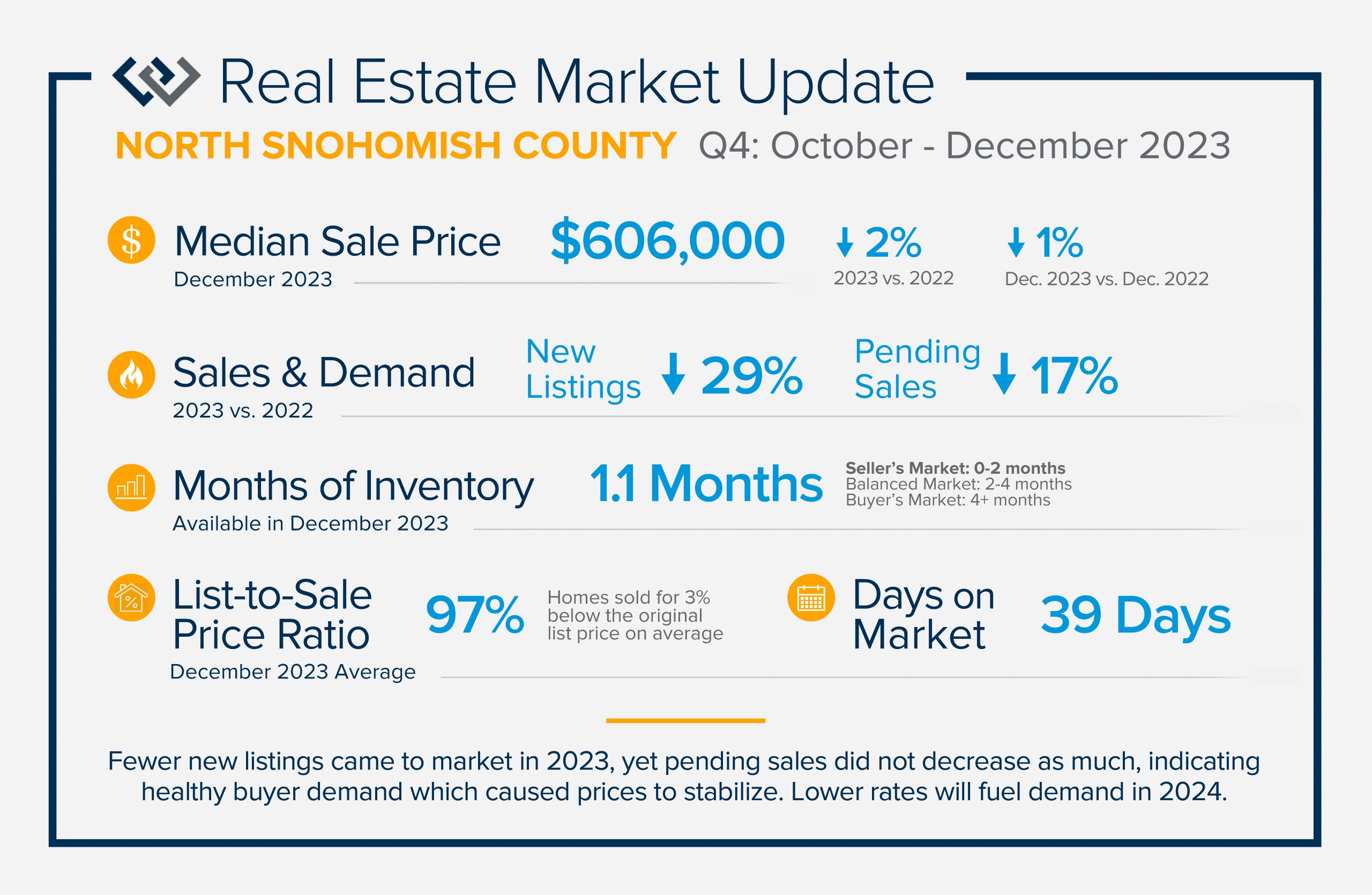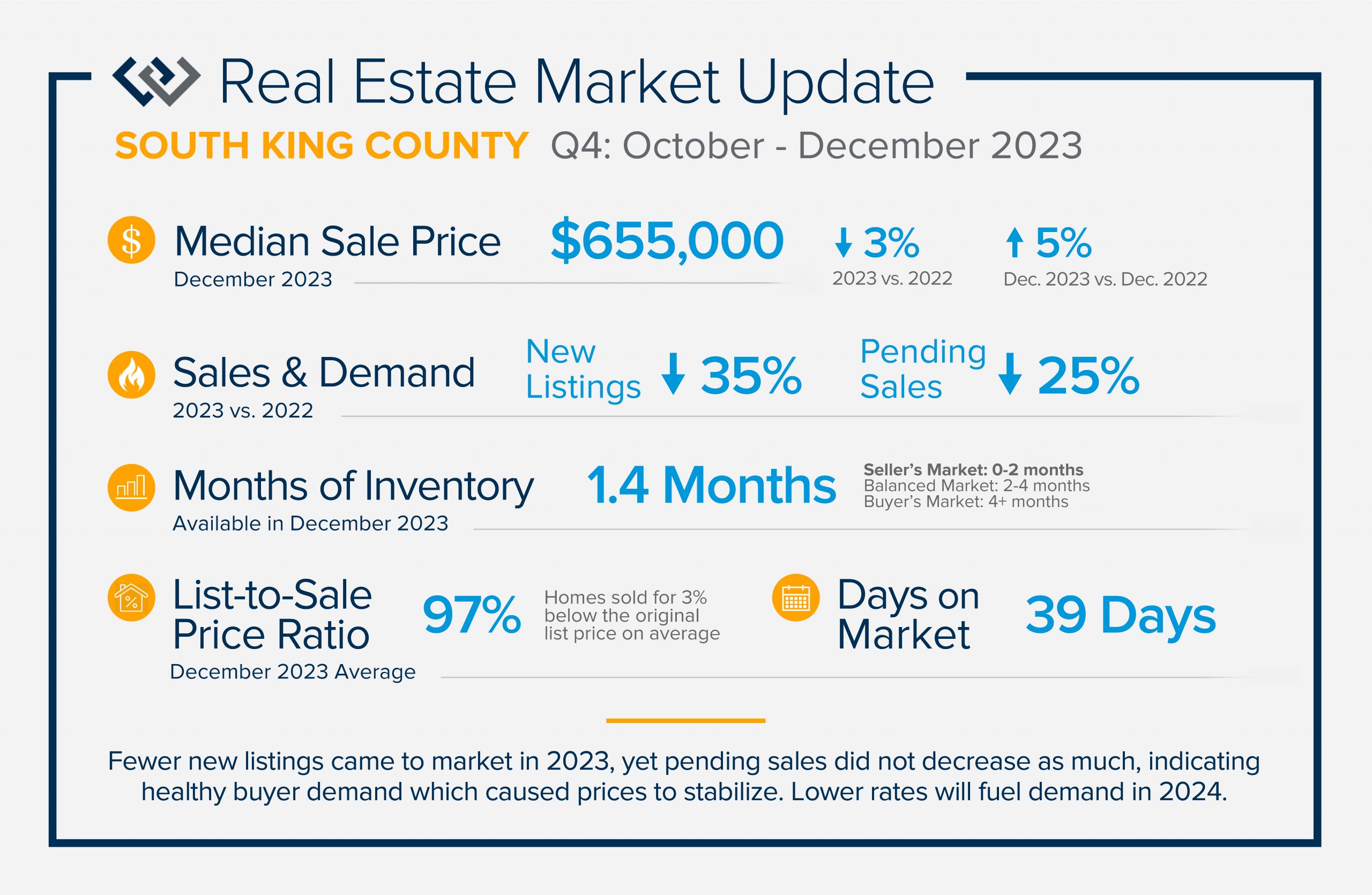Three Hot Buttons in Real Estate

The real estate industry has been in the news a bit lately. Not so much about the trends and home values. More so about class action lawsuits, which have stolen a lot of attention away from the positive activity that is happening in our market. While the lawsuit is an important story to track, one critical item to mention is that WA has already complied with the majority of what the proposed lawsuit settlement is suggesting.
New laws went into place on Jan 1, 2024, that complemented changes our MLS started making in 2019. We have been smooth sailing for almost four months bringing heightened transparency to every real estate transaction we do with new laws, forms, and procedures. The national hype has caused a stir, so before I get into the three important trends, I wanted to let you know that WA is ahead of the curve. If you have any questions on how to distinguish the national headlines from the local truth, please don’t hesitate to contact me.
INFLATION: Interest Rates & Insurance
Inflation has been a hot topic for a few years now. We all know the cost of groceries, gas, and everyday items are higher than they were just a few years ago. This caused interest rates to increase in spring 2022, hovering between 6.25-7.5% over the last 2 years. Despite these rate increases we have watched the real estate market and home values recover and start to appreciate again. The median price in Snohomish County is up 5% in Q1 2024 over Q1 2023 and up 13% in King County. The spring market has sprung!
The lending costs to purchase a home have increased and it has limited and sidelined some buyers. However, many are finding ways to make it work and demand is strong with the return of multiple offers and price escalations on well-priced and presented listings. If you are waiting for rates to come down, also pay attention to prices as it is a delicate balance of affordability. The option to re-finance your interest rate down the road if rates dip will decrease your monthly payment while keeping your loan balance fixed.
Homeowners Insurance has also been hit hard by inflation and a heightened amount of claims over the last four years. Natural disasters such as fires, floods, and earthquakes have depleted many insurance companies’ reserves causing them to re-calibrate their rates across the board to keep up. You may have seen an increase in your rate. With home values and goods on the rise, it is important that you have your home and belongings adequately insured.
I’d suggest you check in with your carrier to make sure they have your home and your belongings properly valued. With market dynamics quickly shifting I’d caution you from grabbing your home value from an online estimator such as Zillow or your insurer’s automated program. Those algorithms are most often inaccurate which could leave you under-insured. I’m happy to help you assess the current value of your home in today’s market so you can properly calibrate your homeowner’s insurance in this volatile insurance environment.
HOME EQUITY Movement:
According to ATTOM data, 67.4% of homeowners in the U.S. have at least 50% home equity, with 38.7% owning their homes free and clear. Locally, the average homeowner in Snohomish County has 57.5% home equity, and in King County 60%. Those local figures were reported in Q4 2023 and we have seen a jump in values since then indicating that those figures are now higher.
The point is that home equity is strong for many homeowners, which allows homeowners who are looking to make a move to use creative options to make those moves smooth. We are in a competitive seller’s market so trying to purchase a home contingent on the sale of your current home is a challenging feat. At Windermere, we have the awesome Windermere Bridge Loan Program (WBLP) that helps people tap into their equity to make their next purchase instead of having to sell their homes first.
The WBLP does not require an appraisal like a Home Equity Line of Credit (HELOC), is quickly approved, and does not require monthly payments. The loan balance and any accrued interest are paid off when the collateral property is sold, allowing buyers who are also sellers to easily utilize their equity and not have to move twice. I’ve even seen the collateral property close first if strategized properly. This eliminates having to fund the Bridge Loan altogether, yet it was used to make that buyer’s offer competitive and helped them win the house for their next chapter in life.
HOME PREPARATION Overwhelm:
One of the biggest tasks I assist clients with is preparing their homes for the market. How a home comes to market can make a huge difference in the bottom line. Remedying deferred maintenance, making home improvements, remodeling, clean-up, purging, and merchandising can all contribute to a seller making more money on closing day. Creating a punch list of items that will create the most favorable return is a service I provide my clients.
Identifying the available funds, hiring service providers, and just getting started can cause overwhelm and sometimes paralysis. As stated above, many homeowners have amazing home equity. Leveraging home equity can help a homeowner complete the projects that will make a better profit! At Windermere, we have the Windermere Ready Program (WRP) which allows home sellers to tap into their equity before coming to market to get their homes market-ready.
Like the WBLP, the WRP is quickly approved, does not require an appraisal, and monthly payments are not required. We figure out which projects we want to focus on, gather bids from trusted contractors, create a budget, and apply. The funds are provided within 2 weeks and we can line up the work and start the transformation immediately.
I’ve seen simple flooring replacements and fresh paint transform a house. We’ve even done a full kitchen remodel to completely change up the vibe. The projects that warm my heart are helping elderly sellers sort through years of living and clearing the space for potential buyers to envision themselves in the home. Did you know that there are companies that help people sort and purge their belongings, so they are prepared to move on to their next chapter? Lastly, we can solve property issues with the WRP! Earlier this year, we discovered a failed septic system on a listing and we were able to utilize the WRP to tackle that fix and made it to the closing table at top dollar.
Markets are fast-paced and dynamic! Helping clients navigate the environment to protect their investment, strategize financing, and/or prepare their property are tasks that I take very seriously. Even if it is as simple or complicated as clearing a house for the market. Whether we are evaluating these items for an immediate move or we are planning out years in the future providing this care matters to me! Please reach out if you or someone you know are curious about how the trends relate to their situation. It is my mission to help keep my clients well informed to empower strong decisions.
QUARTERLY REPORTS Q1 2024

After an almost two-year journey of recovery and stabilization since the spring 2022 correction, the market has started to experience solid price appreciation. The median price in Q1 2024 vs. Q1 2023 shows that despite interest rates remaining stubborn, buyer demand is returning to the market. Improved consumer confidence and acclimation to lending costs have caused price growth, especially amongst tight inventory levels.
New listings are slowly increasing over 2023 as pent-up seller demand meets the market. Equity levels across our region are strong, providing favorable returns for home sellers. Many experts predict interest rates to gradually fall in 2024, estimating they will reach the mid to lower 6% range later this year. While the cost of lending still has some buyers sidelined, many are forging ahead now.
Life changes often determine a move. It is my goal to help empower strong decisions by assessing my client’s lifestyle and financial goals amidst real-time market trends and conditions. Whether you have considered selling, buying, or both, or you’re just curious about the market, please reach out.
Accurate Update: Washington State & the Proposed NAR Settlement

As I am sure you have heard on the news, there is a proposed settlement agreement for the NAR (National Association of Realtors) Class Action Lawsuit. It has certainly stirred up plenty of headlines that have been glossy, and in many cases, inaccurate. Many of the reports and headlines have been national and it is important to note that WA state is unique and could have far fewer changes than the rest of the country if the settlement is approved.
The majority of the MLSs (Multiple Listing Services) across the country are owned by NAR and our NWMLS (Northwest Multiple Listing Service) in WA, is not. NWMLS is not included in the settlement agreement as they are not NAR-owned. If the settlement is approved, they can choose to opt in, which is undecided at this point as it will require a vote of their board of directors.
In WA, new laws were enacted on January 1, 2024 that address many aspects that the settlement agreement is proposing. For years, WA brokers and NWMLS have been committed to elevating transparency around broker compensation, resulting in brokers in WA already doing business as many of the new proposals in the settlement agreement suggest. You can refer to the newsletter I published in early February that outlines the new laws that went into place on Jan 1. I am also happy to report that practicing under these new laws has been positive and productive for consumers and brokers alike.
The proposed settlement agreement still needs to be approved by the court. Once that is done, I will report back to explain how it will affect real estate operations in WA state. In the meantime, I also want to report that market activity in Q1 2024 has been positive!
Price growth is up, buyer demand is strong, and inventory remains low. Seller equity is soaring, with home equity in King County averaging 60% and 57.5% in Snohomish County. These figures were reported in December 2023 and don’t account for the price growth we’ve seen in Q1. Interest rates are still hovering around the high 6% and are predicted to come down this year, yet remain volatile and stubborn. Please reach out if you or someone you know would like to learn more. It is always my goal to help keep my clients informed and empower strong decisions.
Phill was Right! Spring Arrives Early for our Local Real Estate Market

When Punxsutawney Phill climbed up to his perch at Gobblers Knob on February 2nd and did not see his shadow, an early spring was predicted. Little did we know that he would be referring to the real estate market! As we experience temps in the 30s and scattered snow showers in the first week of March, we are also experiencing a white-hot seller’s market.
We started 2024 with the lowest amount of inventory we have seen since the beginning of 2022. Over the last 2 years, we have experienced a correction and recovery in the real estate market due to inflation and interest rates. The market peaked in April 2022 in Snohomish County when the median price reached $830,000, and in May 2022 in King County when prices reached $1M. Prices started to correct when rates crested 5% in April 2022 and then found themselves squarely at 7% by October 2022. This rapid 2-point increase put downward pressure on prices and stalled buyer and seller demand.
Loan servicing affordability caused prices to bottom out in Snohomish County in February 2023 at $685,000, and in King County in January 2023 at $800,000. The bulk of the correction took place in 2022, and 2023 was the year of resetting price stability and the return of appreciation. What was fascinating about this growth is that interest rates still averaged around 7% throughout 2023.
In Snohomish County prices were up 6% in February 2024 over February 2023, and in King County they were up 16%, and rates are still hanging around 7%. Since the first of the year, it was like a switch went off for many buyers and demand flooded the market. The feedback that I am hearing is that many buyers have adapted to the new normal of interest rates and will refinance when rates come down; but they want to buy now. The increase in buyer demand coupled with the lowest inventory we’ve seen in two years has caused a flurry of multiple offers, price escalations, and an early start to the spring market.
Now that we are certain buyers are back, the next effective change in the market would be the addition of more inventory. This would meet the demand and create more movement in the market. We are well aware that many homeowners are reluctant to make a move because they don’t want to give up their low rate/payment. We also know that because of this, many would-be sellers are living in homes that do not match their needs and wants.
This pent-up seller demand is starting to come to market, but more is needed. The average level of equity in Snohomish County was reported at the end of 2023 at 57.5% and in King County at 60%. With the recent uptick in median price, this level is growing, which will allow many sellers to move their equity into a home that better fits their lifestyle. This growth should also be supported by interest rates slowly coming down throughout 2024.
The latest predictions from the Home Price Expectation Survey (HPES) have rates decreasing to 6% by the end of 2024 which will only add to buyer demand, highlighting the need for more listings. If you are a homeowner and your house is not matching your life, now might be the time to consider a move! What has already transpired in the first 2 months of 2024 has been encouraging for seller gains.
Writing a playbook and creating a strategy to make these transitions requires a well-curated plan. It is my mission and passion to help clients make these moves. There can be challenges to overcome along the way, such as does one sell or buy first and how to do you get your home ready for market. Tools such as the Windermere Bridge Loan, The Windermere Ready Loan, and other alternative financing have helped make these dreams become a reality. That is why hiring a professional who is well-versed in market knowledge, creative planning, expert marketing, and keen negotiations is key!
Please reach out if you or someone you know is curious about the market and how it relates to your financial and lifestyle goals. Real estate reflects life and if there is one constant in life, it is change! Helping people match their homes to their lives is one of the most rewarding aspects of my job. The adjustments over the past two years got in the way of many people making those matches. As the market and consumer confidence continue to open up, don’t let this opportunity pass you by. It is my goal to help keep my clients well-informed and empower strong decisions whether that works for you now or sometime down the road. Let’s talk it out, dig deep into the trends, and start your strategic planning with no pressure.
New Year, New Laws! What This Means for Consumers Moving Forward.

Effective January 1, 2024, the statute in Washington that governs real estate brokerage relationships (RCW 18.86) otherwise known as the “Agency Law” – was significantly revised. The revisions modernize the 25-year-old law, provide additional transparency and consumer protections, and acknowledge the importance of buyer representation.
KEY REVISIONS
For decades, real estate brokerage firms were only required to enter into written agency agreements with sellers, not buyers. The Agency Law now requires firms to enter into a written “brokerage services agreement” (agency agreements) with any party the firm represents, both sellers and buyers.
This change is to ensure that buyers (in addition to sellers) clearly understand the terms of the firm’s representation and compensation, much like a listing agreement. The new agreements are called Buyer Brokerage Service Agreements (BBSA) and they are to be initiated in writing prior to or upon rendering real estate brokerage services, such as showing homes.
The services agreement with buyers must include:
- The term of the agreement (with a default term of 60 days and an option for a longer term);
- The name of the broker appointed to be the buyer’s agent;
- Whether the agency relationship is exclusive or non-exclusive;
- Whether the buyer consents to the individual broker representing both the buyer and the seller in the same transaction (referred to as “limited dual agency”);
- Whether the buyer consents to the broker’s designated broker/managing broker’s limited dual agency;
- The amount the firm will be compensated and who will pay the compensation; and
- Any other agreements between the parties.
Clearly communicated expectations between the buyer and their broker are an advantage to the buyer. Every party deserves representation and it has been a long time coming for the law to pay as much attention to buyers as it has to sellers. Having competent representation on both sides of a transaction makes the process go smoother and reduces liability during and after the transaction. After all, everyone deserves competent representation during one of the biggest transactions they will partake in.
These changes are intended to elevate transparency in agency relationships for the consumer and encourage more detailed conversations about representation, compensation, and the overall home buying process with the broker they chose to align with. This will also cause sellers to gain a better understanding of how buyer brokers are compensated.
What a seller chooses to offer a buyer broker could have a positive effect on their return. The only way a buyer can compensate their broker is with liquid cash or negotiating with the seller within the purchase and sale agreement when their BBSA doesn’t match the seller-offered compensation for the buyer broker. If their BBSA matches what the seller is offering in the listing for the buyer broker compensation, then the buyer does not have to rely on the prior.
Compensation offered in a listing that mirrors the BBSA will allow a buyer to solely focus on the offer price of the home as they will not have to calculate the math of the compensation against their down-payment funds, as lending regulations do not allow for broker compensation to be financed. If a buyer has to set aside funds for compensation it would likely reduce their down payment amount which would increase their monthly payment and make them more price sensitive. It will also eliminate the compounding effect of compensation and the offer price being simultaneously negotiated.
I have always run my business in a very detailed fashion and pride myself on having a deep knowledge of the laws and the forms, and these changes are paramount. As an independent contractor affiliated with Windermere Real Estate, the leading company in our region, it is up to me to dig into the research and gain understanding to help guide my clients through these advancements in a compliant and service-oriented fashion. There are even aspects of these new laws that I have been practicing before the changes, as transparency is a cornerstone of my value to my clients.
These are the biggest changes we have seen in our industry in over two decades. Be aware that not all brokers will adapt as quickly or accurately. We are already seeing a gross difference between the informed and not informed; who one chooses to work with matters! If you have any further questions about how these new laws affect you, please reach out. If you are considering a move, I am committed to navigating the process with the utmost compliance and my client’s success at the forefront.
REVISED PAMPHLET: The pamphlet entitled “Real Estate Brokerage in Washington” provides an overview of the revised Agency Law.
REVISED AGENCY LAW: Substitute Senate Bill 5191 sets forth the revised Agency Law in its entirety.
Matthew Gardner’s 2024 Economic Forecast Highlights

Last week, my office hosted our 16th Annual Economic Forecast Event featuring Matthew Gardner. Matthew is a sought-after economist focused on the national and local economies and has a deep understanding of the housing market across the country and right in our own backyard. He is an economic advisor for the State of Washington, Governors Council, lectures on real estate economics at the University of Washington, and is found quoted in various media outlets throughout the year as a respected expert. He is certainly a trusted real estate advisor that I look to to stay informed to help educate my clients.
The event was virtual and I have the recording and his PowerPoint in a PDF that I am happy to share with you, please reach out if you would like me to email it to you. So much was shared in his 60-minute presentation that was focused on the national economy and a deep dive into both King and Snohomish Counties, followed by Q & A. I can’t quite cover it all here, but here are some highlights!
- Inflation levels have dropped from their peak and are now tracking with more normalized levels. This has caused interest rates to start to drop, which is a trend he sees continuing in 2024.

- The U.S. unemployment rate measured at 3.8% at the end of 2023 and is forecasted to rise ever so slightly and remain under the long-term average of 4.5%. In King and Snohomish Counties the unemployment rate averaged 4% at the end of 2023.

- There is a major labor gap in both King and Snohomish Counties, with job postings heavily outweighing labor supply. Biotech is the darling of the moment which will balance out the IT side in the overall jobs picture.

- Interest rates are predicted to gradually decrease throughout 2024 as inflation softens. The Fed will slow-play these reductions to get them right, so they do not have to raise them again.

- The Tri-County area of Snohomish-King-Pierce Counties had massive organic population growth from 2020-2022, much of which was international vs. domestic.

- Homeowner equity averages 60% in King County and 57.5% in Snohomish County. According to the median price in King County in December 2023 that is $511,200 and $391,000 in Snohomish County. Homeownership proves to have the strongest impact on household wealth.

- There will NOT be a bubble in the housing market! Given that prices remained stable in 2023 amongst the highest interest rates we’ve seen in two decades along with inflation at a high, the housing market has proven to be a fortuitous economic marker. Rates and inflation are both improving, which will bode well for home values. Our biggest challenge is the lack of inventory and affordability.
- Price growth in King and Snohomish Counties was flat year-over-year (2022 to 2023) after massive growth from 2020-2022, which was positive given the correction in prices and rise in interest rates. Prices are forecasted to modestly increase in 2024. Tight inventory and continued buyer demand will drive this growth while interest rates temper.

Please reach out if you would like to learn more and receive the documents and recording. Also, you can count on me to follow the trends, statistics, and rhythm of the market throughout the year. It is my goal to gain knowledge and understanding so I can help keep you informed. This level of service helps empower my clients to make thoughtful, sound decisions when navigating their investments and big life choices.
QUARTERLY REPORTS Q4 2023

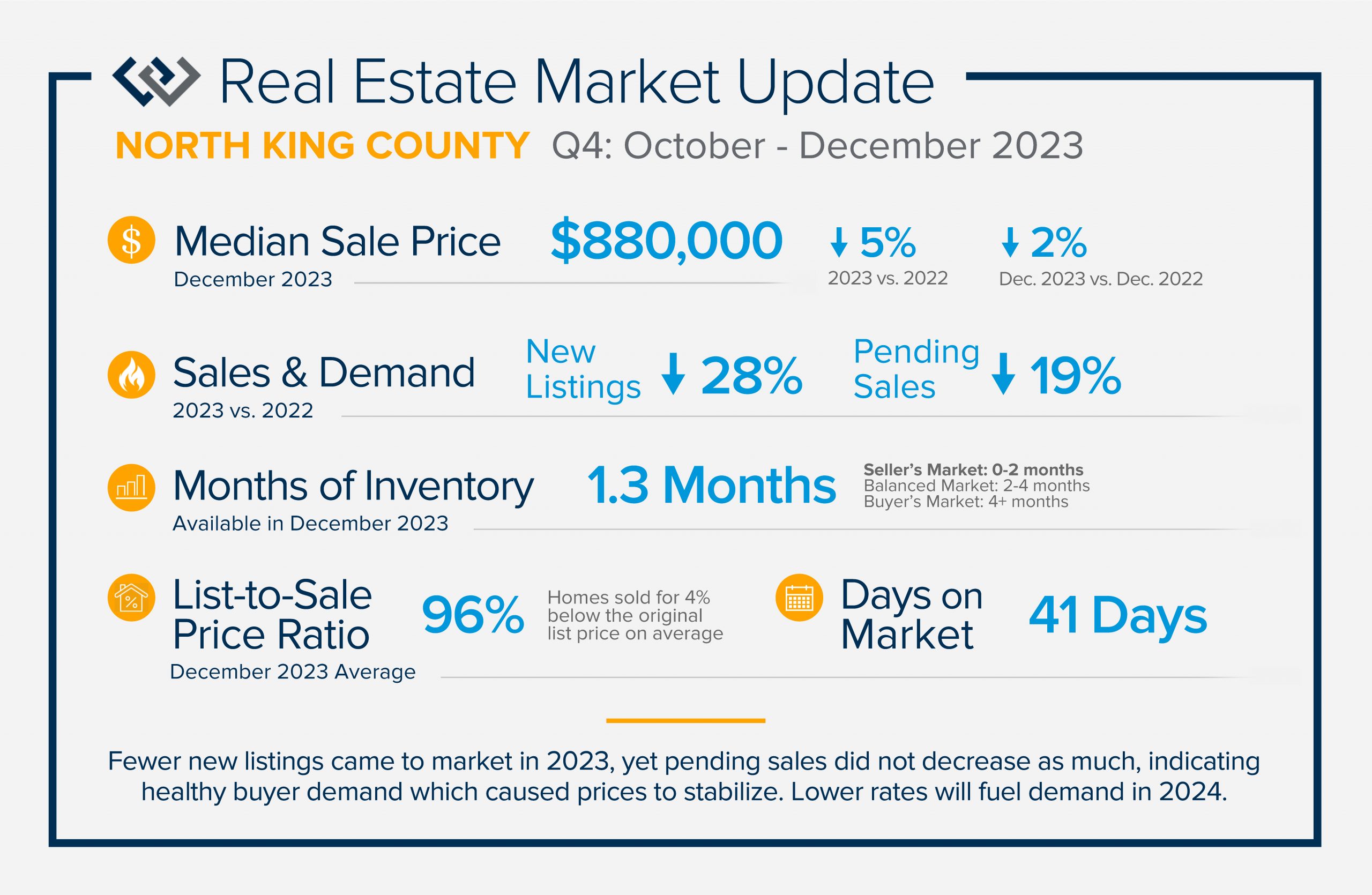
 The story of 2023 was balancing interest rates with home purchases and even home sales. The average weekly rate in 2023 was 6.8% and peaked in October at 7.94%. This caused some buyers to pause due to cost. Many sellers were reluctant to move and give up their low payments based on historically low rates, hence the large decrease in new listings in 2023.
The story of 2023 was balancing interest rates with home purchases and even home sales. The average weekly rate in 2023 was 6.8% and peaked in October at 7.94%. This caused some buyers to pause due to cost. Many sellers were reluctant to move and give up their low payments based on historically low rates, hence the large decrease in new listings in 2023.
Despite the highest rates we’ve seen in two decades, pending sales did not falter like new listings, indicating continued demand and resulting in a seller’s market. Inventory remained tight throughout 2023 and prices stable over 2022 (the peak) when the average rate was 5.34%. Since October, rates have come down by over 1%, bringing more buyers to the market. The Fed plans to continue this trend in 2024 which will increase buyer activity and new listings. 2024 will provide improved opportunities for all with a less stringent lending environment.
If you are curious about how the trends relate to your goals, please reach out. I strive to keep my clients well-informed and empower strong decisions.
December is for Giving at Windermere North!

 The holiday season can come and go in a flash, with the pressure and stress of gift shopping, family obligations, and wrapping up the year. One thing that I love about my office is that we all make it a priority to come together to lift up our neighbors in need during this time of year.
The holiday season can come and go in a flash, with the pressure and stress of gift shopping, family obligations, and wrapping up the year. One thing that I love about my office is that we all make it a priority to come together to lift up our neighbors in need during this time of year.
This year our holiday food drive brought in $3,115 and 1,787 pounds of food for Volunteers of America Western Washington food banks, just in time for the holidays. The current need in our area is high, and our local food banks need all the help they can get. These numbers are all thanks to friends and clients like you. Thank you for your generosity!
Next, we had the absolute joy to help bring some Christmas magic to homeless/housing insecure youth in our area. We partnered again this year with WA Kids in Transition, who work with social workers in the Edmonds School District to collect wish lists from students living in shelters, tents, cars, transitional housing or other temporary housing. Together, the brokers in my office provided gifts and hygiene items for 28 kids.
Then we provided $3,700 in grocery gift cards for 13 families, comprised of 60 individuals. Some of these families are unemployed or living in transitional housing, some are walking through grief and loss, and some are coming out of domestic violence. It is our privilege to partner with Pioneer Human Services, to help lift some of the burdens for these families.
Next, we always put together a volunteer group at Christmas House in Everett. Christmas House is a 100% volunteer, non-profit organization that provides an opportunity for qualifying, low-income, Snohomish County parents to select free holiday gifts for their children age infant-18. This is an amazing day helping families in need have a joyful Christmas.
 Are you curious about the economy during these changing times?
Are you curious about the economy during these changing times?
Are you trying to make financial plans, but crave credible information to assist you?
Please join me for a very special virtual live event:
AN ECONOMIC FORECAST FOR 2024 & BEYOND
with Matthew Gardner
Notable Real Estate Economist
Wednesday, January 17, 2024 • 6:30 pm – 8 pm
Presentation from 6:30-7:30 pm, Q&A to follow
Please RSVP to me via phone, text, or email by January 12th, 2024 to receive an emailed link to access the event.
Decor Corner: Thanksgiving Table Tips!

Now or Later: When Rates Drop, Expect the Market to Tilt

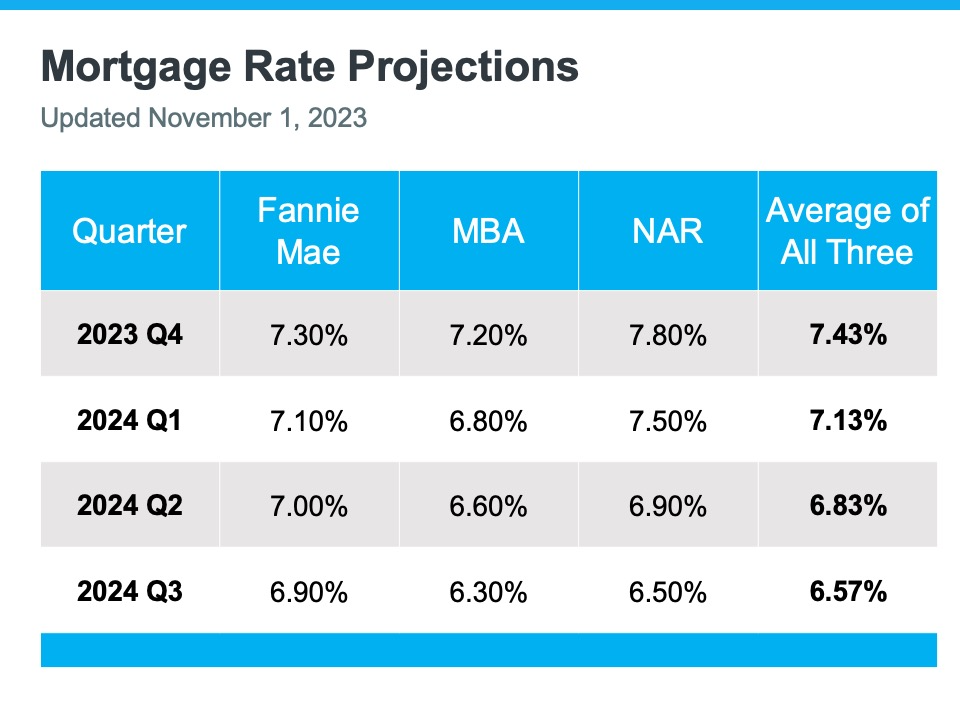 The question that many potential buyers are asking themselves right now is: should I wait for rates to drop before I buy? Higher interest rates have certainly made monthly payments higher and challenged overall affordability, however it is important to consider creative financing options and what the impact on prices will be once rates lower.
The question that many potential buyers are asking themselves right now is: should I wait for rates to drop before I buy? Higher interest rates have certainly made monthly payments higher and challenged overall affordability, however it is important to consider creative financing options and what the impact on prices will be once rates lower.
Experts predict rates to decrease over the next 12-18 months. In fact, we have seen rates drop half a point over the last 30 days. Currently, the 30-year conventional rate is hovering about 7.5%. We saw a correction in prices when rates jumped by a point and crested 6% in mid-2022. Since Dec 2022, prices found their bottom, and price appreciation started happening again. Year-to-date, the average interest rate has been around 7% and prices have not been in a free fall, they have grown and remain stable.
 Just like the correction that happened in 2022, it is safe to say there is a correlation between prices and rates. If the experts are correct and rates fall over the course of the next year or so, we should anticipate prices to increase. That is what hangs in the balance when making the decision of whether to buy now or later. The example to the right shows the effect that price appreciation will have despite rates being lower. It was not that long ago that we were experiencing bidding wars where homes escalated in the double digits. As you can see, the higher price results in a higher payment even with the lower rate.
Just like the correction that happened in 2022, it is safe to say there is a correlation between prices and rates. If the experts are correct and rates fall over the course of the next year or so, we should anticipate prices to increase. That is what hangs in the balance when making the decision of whether to buy now or later. The example to the right shows the effect that price appreciation will have despite rates being lower. It was not that long ago that we were experiencing bidding wars where homes escalated in the double digits. As you can see, the higher price results in a higher payment even with the lower rate.
If one is able to afford a purchase now with today’s rate, they can refinance when rates go down and save themselves a lot of money on their payment while keeping a fixed price. Additionally, if a buyer can secure a rate buydown, such as a 2-1 buydown, the higher rates can be overcome and a refinance can fix the rate when the rates drop.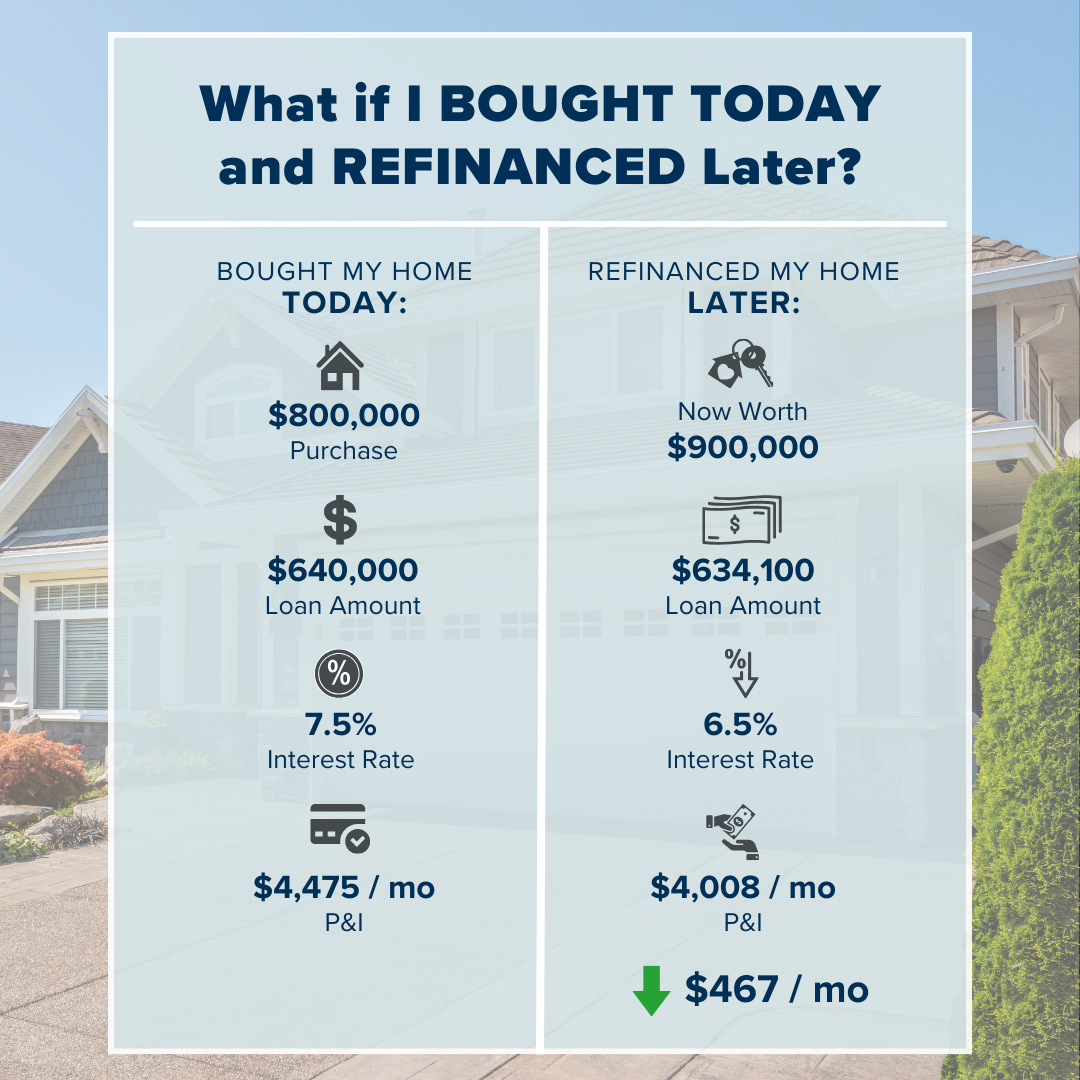
Here is an example: let’s say you are shopping for a house and have the same $800,000 budget and a 20% down payment with today’s rate of 7.5%. The monthly principal and interest payment would be $4,475.00. You could do a 2-1 buydown (2-points lower in year one and 1-point lower in year 2) which would have your payment in year one be based on an interest rate of 5.5% with a monthly principal and interest payment of $3,534 – a savings of $841.00 per month. For year two, the monthly principal and interest would be based on 6.5% resulting in a monthly payment of $4.045.00, a $430.00 per month savings. The total savings in monthly payments with the 2-1 buy-down over the two years would be $15,252.00.
The roughly $15,000 in monthly payment savings is paid upfront at closing and in some cases paid by the seller. The buyer still needs to qualify based on the 7.5% interest rate as the payments will convert to the payment based on the 7.5% in year three moving forward. The strategy here is to never have the payment increase to 7.5% because the buyer plans to refinance when rates come down, and will permanently fix their rate below 7.5%. A bonus is that if the entire $15,000 credit has not been used yet, in some cases those funds can be applied towards the refinance.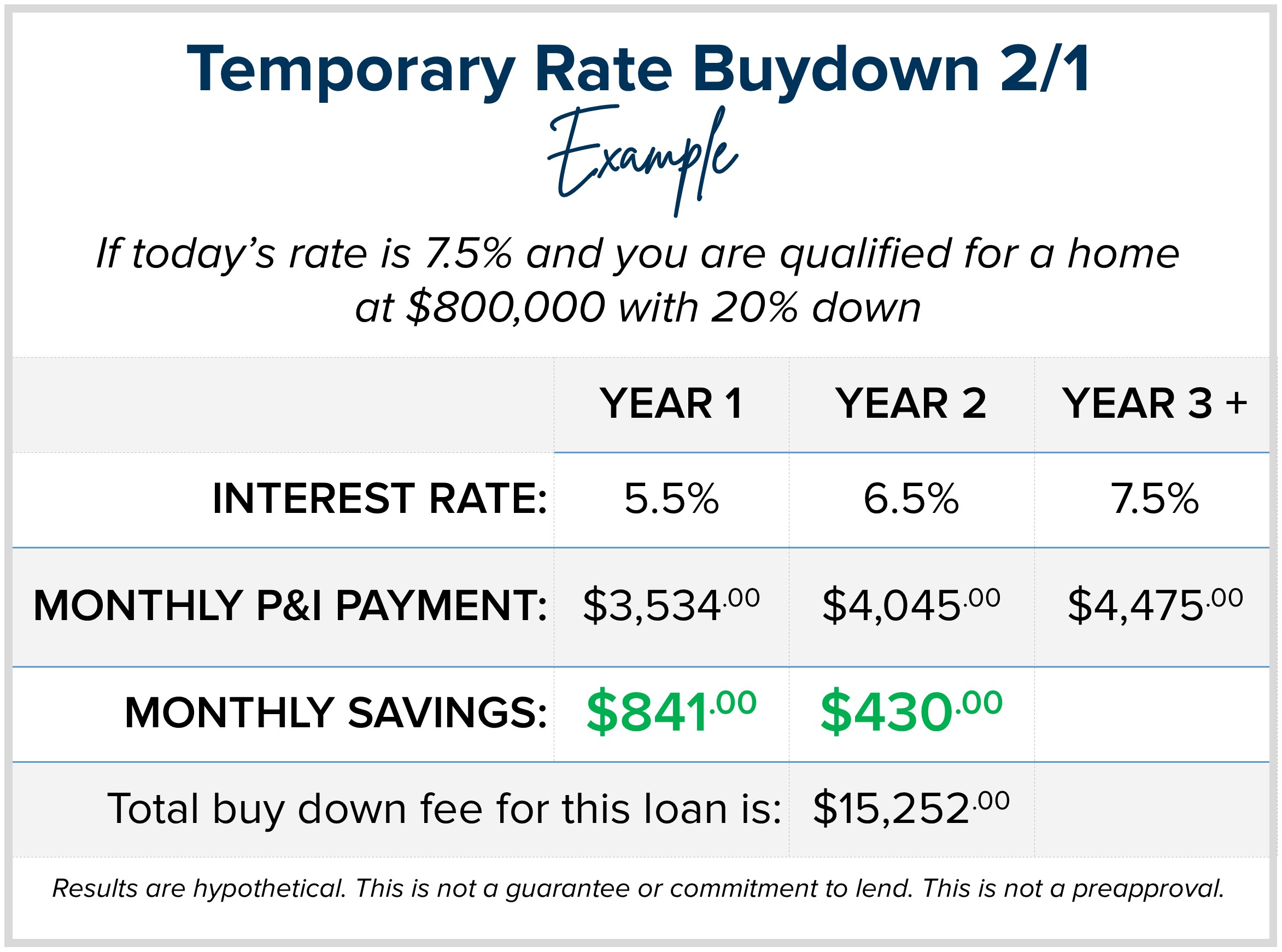
You see, there are many options to consider when a buyer is balancing rates, prices, payments, and their desire to make a move. I understand that I am in the business of helping people navigate big life changes while ensuring their financial investment is sound. I felt it was an important message to share these examples in case you or someone you know was thinking about making a purchase but was feeling confused or stifled by the current rate environment. If you want to learn more or need a referral to a reputable lender, please reach out. It is always my goal to help keep my clients well-informed and empower strong decisions.
As we approach the Thanksgiving holiday, I want to let you know how grateful I am for YOU! Your friendship, support, and referrals have helped fuel my business and support my family. Thank you!
Real estate is a career that gives me the opportunity to be a meaningful part of my clients’ lives as they navigate important moves that have a great financial impact. I take the responsibility of guiding my clients through this process very seriously and know that when someone places this trust in me that it is a big deal! It is an honor to be a part of your big-picture planning and to help you execute these life changes with care and success.
My Thanksgiving would not be complete without taking a moment to say thank you and that I appreciate you so much! I hope your holiday is filled with happiness, rest, and all the people that are nearest and dearest to your heart.
 Facebook
Facebook
 X
X
 Pinterest
Pinterest
 Copy Link
Copy Link
